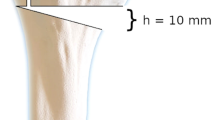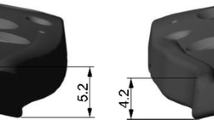Abstract
Treatment for comminuted proximal humerus fractures and nonunions are a substantial challenge for orthopedic surgeons. Plate and screw fixation does not provide enough stability to allow patients to begin functional exercises early after surgery. Using shape memory material nickel titanium alloy, we designed a new device for treating severe comminuted proximal humerus fractures that accommodates for the anatomical features of the proximal humerus. Twenty-two cases of comminuted fracture, malunion, and nonunion of the proximal humerus were treated with the proximal humeral memory connector (PHMC). No external fixation was needed after the operation and patients began active shoulder exercises an average of 8 days after the operation. Follow-up evaluation (mean 18.5 months) revealed that bone healing with lamellar bone formation occurred an average of 3.6 months after surgery for the fracture cases and 4.5 months after surgery for the nonunion cases. Average shoulder function was 88.5 according to the criteria of Michael Reese. PHMC is an effective new device to treat comminuted proximal humerus fractures and nonunions. The use of this device may reduce the need for shoulder joint arthroplasty.





Similar content being viewed by others
References
D. Browner, Skeletal Trauma, 3th ed., Elsevier Science Health Science div., 2003, p 1570–1571
X. Tang, W. Qu, S. Wang et al., AO Locking Proximal Humerus Plate Treatment of the Fracture of the Proximal Humerus, Chin. J. Trauma, 2003, 19, p 625–627
A. Kocialkowski and W.A. Wallace, Closed Percutaneous K-wire Stabilization for Displaced Fractures of the Surgical Neck of the Humerus, Injury, 1990, 21, p 209–212
P.G. Stableforth, Four-part Fractures of the Neck of the Humerus, J. Bone Joint Surg. (Br), 1984, 66, p 104–108
S.K. Moda, N.S. Chadha, S.S. Sangwan et al., Open Reduction and Fixation of Proximal Humeral Fractures and Fracture-dislocations, J. Bone Joint Surg. (Br), 1990, 72, p 1050–1052
H. Lin, Z. Zha, G. Wang et al., Replacement of Humeral Head Prosthesis for Complex Fractures of Proximal Humerus, Chin. J. Trauma, 2003, 19, p 410–412
K. Otsuka and C.M. Wayman, Shape Memory Materials, Cambridge University Press, 1999, p 189–197
C.C. Zhang, S.G. Xu, J.C. Su, et al., “Bow-Tooth-like Memory Compressive Connector (I),” Patent NO: ZL ZL 01 3 44222.8, 1st September 2001
M. Speck and P. Regazzoni, Vier-Fragment-Frakturen des proximalen Humerus: Alternative Strategien der chirurgischen Behandlung, Unfallchirurg, 1997, 100, p 349–353
A. Werner and A. Hedtmann, Surface Replacement Shoulder: Arthroplasty Indications and Limits, Orthopade, 2007, 36, p 996–1001
Acknowledgment
This research is supported by a grant from National Natural Science Foundation of China (No. 30872640/C160705).
Author information
Authors and Affiliations
Corresponding author
Rights and permissions
About this article
Cite this article
Xu, SG., Zhang, CC. Design and Clinical Application of Proximal Humerus Memory Connector. J. of Materi Eng and Perform 20, 143–146 (2011). https://doi.org/10.1007/s11665-010-9647-8
Received:
Revised:
Published:
Issue Date:
DOI: https://doi.org/10.1007/s11665-010-9647-8




